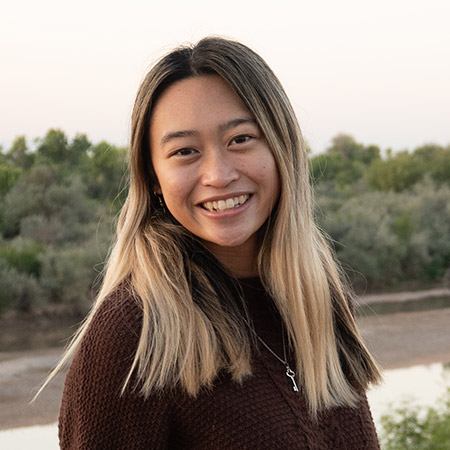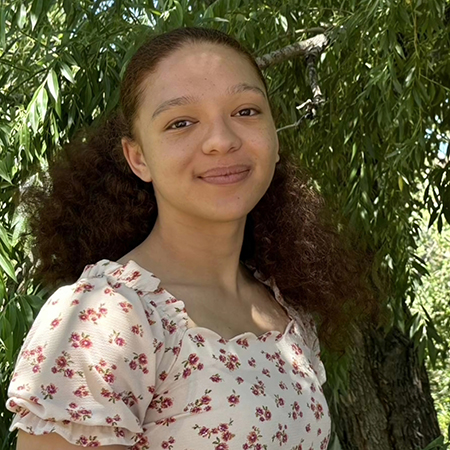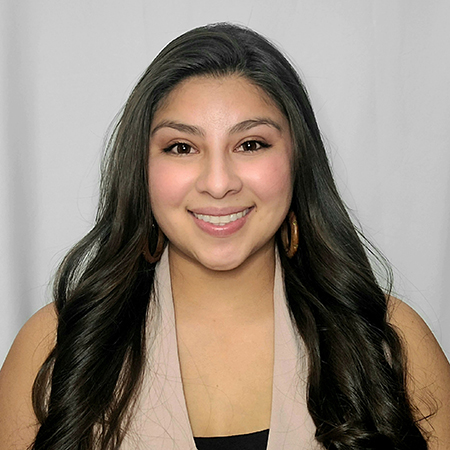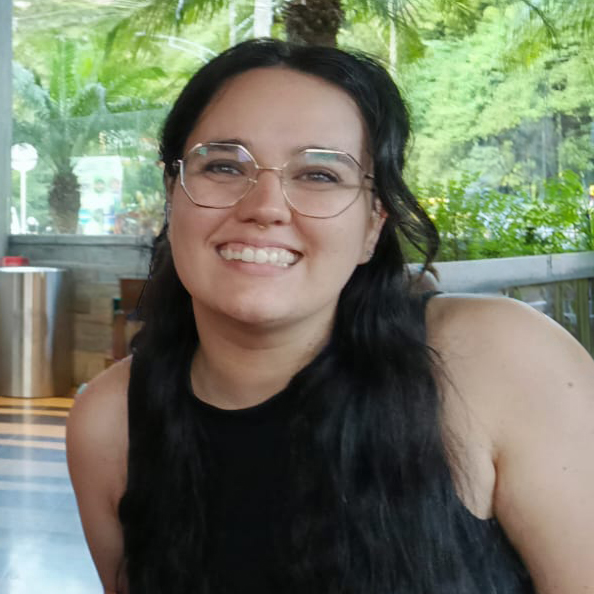Testimonials from past fieldwork students, Summer 2024.

"At AgrAbility, I research the overall health and well-being of the underserved population of agricultural workers with intellectual and developmental disabilities (IDD). I also work directly with the population at the AgrAbility site here in New Mexico, Mandy’s Farm. This hands-on experience has allowed me to observe the research I do, conduct it with practical outcomes, and deepen my understanding of the challenges faced by the population. At the end of the semester, I plan to present an intervention to the apprentices who work at Mandy’s Farm to help improve their overall health and well-being.
Along with this opportunity, as an aspiring student in the occupational therapy program, I can work with students doing their fieldwork at Mandy’s Farm. This exposure allows me to observe their work firsthand, giving me a deeper understanding of how occupational therapy principles are applied in real-world settings. It also helps me tie the concepts I'm learning to OT and population health, enriching my perspective as I grow in my academic and professional journey."
- Athena Paguio

"During my eight-week summer program, I collaborated with Dr. Eric Carbonneau, the Chief Operations Officer (COO) of TriCore Reference Laboratories, to identify patient-specific variables influencing laboratory draw site traffic and their links to socioeconomic statuses. TriCore, the largest lab in New Mexico, serves all major hospitals and about 60% of the state's population.
My responsibilities included weekly meetings with the COO, identifying relevant variables through data analysis, querying databases, performing geospatial analysis, summarizing data, and assessing the impact of hypothetical draw site closures on patients. The project began with data cleaning for accuracy and reliability, using SQL to query databases. I extracted data including demographics, ordering providers, ICD-10 codes, draw sites, encounter dates, and patient encounters. I geocoded patient addresses to assign latitude, longitude, and corresponding census tracts.
My analysis identified key variables such as average distance per draw site and patient demographics, including race, age, and sex. Statistically significant differences (p-value < 0.05) were found among socioeconomic groups, highlighting disparities in healthcare access. In the final research phase, to be completed after my practicum, I will propose recommendations to TriCore's Executive Team on optimizing draw site locations. This includes suggestions for strategically locating new sites and enhancing existing ones to improve patient access. This program offered valuable experience in applying data analysis and geospatial techniques to enhance patient access and address health inequities.
Overall, this program provided a valuable opportunity to apply data analysis and geospatial techniques in a real-world setting, contributing to TriCore's efforts to enhance patient access and address health inequities."
- Gabriel Garcia

"The Power of Food: Three Sisters Kitchen Internship Abstract My Practicum experience was far more delightful, rewarding, and time-consuming than I thought it would be. My site preceptor Lisa Chen or, Liang-Yin Chen, was wonderful in putting me in situations where my insight was asked for. As the Community Health Programs Director, Lisa coordinated the logistics of the many projects of Three Sisters Kitchen, giving me the opportunity to lead and collaborate in different projects across programs. Lisa did an amazing job and creating and updating a work plan for me, so that I knew what specific tasks needed to be done, and when. Right off the bat, Lisa asked me to think of an additional project that I would like to do during this practicum alongside my involvement in the ReFresh program, and I decided to do a Community Cookbook. I was also involved in the Together 4 Brother (T4B) program, the National Diabetes Prevention Program (NDPP), and the Community Cooking Classes. I was also asked to create two Community Cooking class agendas, one in collaboration with Kyle White, and was asked to lead classes both online and in person. I also helped gather and clean survey data, translating some participants answers from Spanish to English, and then creating charts and graphs. I also helped distributed ReFresh bags of produce to program participants, while texting them beforehand about pickup times and class dates. TSK has overall been a wonderful experience for me, and I am glad I picked them for my practicum."
- Aya Williams

"My practicum experience took place at The University of New Mexico (UNM) Prevention Research Center (PRC) under the PI, Theresa H Cruz. I worked closely with Theresa H Cruz, deputy director of the PRC and her team of professional interns and associate scientists on various community driven projects. The UNM PRC prioritizes community-engaged research to improve the health and well-being of underrepresented communities across New Mexico. Utilizing evidence-based research, evaluation, and dissemination methods and partnering with communities and diverse stakeholders throughout the research process, it seeks to center the needs and concerns of communities. The projects I worked on throughout my practicum experience were the SNAP-ED evaluation, the Infant Safe Sleep project, and the REACH program. All projects that have different initiatives and goals. The SNAP-Ed Evaluation focuses on evaluating programs to increase healthy eating and active living. The REACH (Racial and Ethnic Approaches to Community Health) program is funded by the CDC promote programs who are dedicated in reducing health disparities by working to change systems and environments to promote better health and help reduce chronic disease. The Vaccine Equity Conference was a project under the REACH grant, and the PRC was tasked to help evaluate this conference. The Infant Safe Sleep project was focused on trying to understand why families with infants do not follow evidence-based guidelines to prevent sudden unintended infant death (SUID). I engaged in each project through various tasks such as qualitative and quantitative data collection and analysis, report writing, presentation development, and data entry."
- Cassandra Acosta

"The World Health Organization determined that cervical cancer is on the path to global elimination. The goals include increasing HPV vaccination for 90% girls aged by age 15, cervical cancer screening for women and girls by age 35 and 45 and timely access to treatment for patients who develop malignancies at a global level. Most of the epidemiological research has focused on vaccination and screening, with limited studies on treatment access. At a global level, the evidence is concentrated in high-income countries, with quantitative data lacking in middle income countries. Treatment start facilitators and barriers are crucial to understand, given that timely initiation of treatment is essential for increasing overall survival. As such, in my MPH practicum I will be evaluating the relationship of di erent sociodemographic and clinical factors that are related to the treatment adherence and timely access to cervical cancer treatment. Through the Cancer Epidemiology Education in Special Populations (CEESP) Fellowship, I conducted my research project at the Universidad de Antioquia School of Public Health under the guidance of Isabel Garcés Palacio, in collaboration with Iader Rodriguez and Marcela Hernandez from the Epidemiology and Applied Research Department at Clínica de las Américas in Medellin, Colombia. At the end of the fellowship, I will have completed the literature review and analysis of a 1,042 patient data set, prepared the manuscript for publication and taking the project to the American Cancer Education Conference in September 2024."
-Sofia Olay